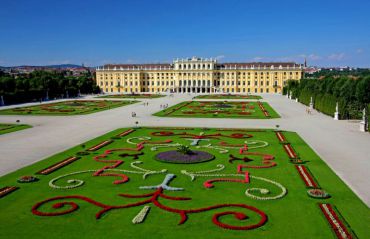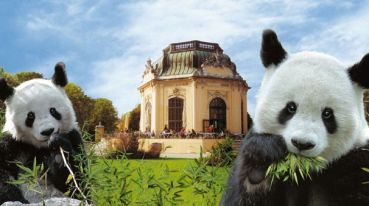The Republic of Austria
Austria is a country of mountain peaks, clear lakes, and cool forests. It is located in the heart of Europe. Beautiful Alpine landscapes, ski resorts, ancient castles, and luxurious palaces, as well as the famous Vienna Ball have brought world fame to Austria. Magnificent royal residences and holy cathedrals, among which St Stephen’s Cathedral is considered the most beautiful one, attract to the country those to be fond of architecture. Austria is a paradise for admirers of classical music, who come to the country in order to enjoy waltzes of the world famous composer Johann Strauss, as well as for visiting the Vienna State Opera. The architecture of Vienna and Salzburg, quiet villages of Tyrol, as well as national parks of Austria are all worth seeing. Gourmets associate this country with spicy mulled wine, appetizing Wiener sausages, and delicate apple strudel.
Since the origin of Austria, the Danube has been its symbol. White band on the national Austrian flag symbolises the river, which is also present on state symbols, in folklore, and in the spirit of Austria. You can find the river’s image on souvenirs too. The Danube flows from the west to the east across the whole country. You can take a memorable boat trip along the river or have a nice dinner in a cosy Austrian restaurant on a picturesque bank of the Danube.
The capital of Austria – Vienna, a romantic and imperial city, – is located on the Danube. Its architecture will impress you: mansions in the style of Baroque; Schönbrunn Palace, an outstanding residence; wonderful buildings in the style of Art Nouveau; as well as Haas House, a building with elements of Postmodernism. For a long time, Vienna used to be the residence of the Habsburgs, and the capital of the Holy Roman Empire. Today, the city is the centre of European and world politics. Vienna hosts headquarters of international organizations, such as OSCE and OPEC; as well as Vienna International Centre, where several UN organisations in Vienna are located.
Vienna is referred to as the musical capital of Europe. Vienna Opera attracts a lot of theatre-goers to the capital. In mid-February, the Vienna State Opera hosts Vienna Opera Ball.
Music, art, and architecture achieve perfection in the city of Salzburg, a birthplace of Amadeus Mozart. Austria is rightly seen as a country of great musicians and writers. Schubert, Strauss, Haydn, and Mahler created their masterpieces there. Mozart and Beethoven spent most of their lives in Vienna. In addition, Salzburg is often called as the city of temples and religious buildings. In former times, the city was ruled by bishops, not princes or dukes. Salzburg Cathedral stands out for its majestic architecture, and St Peter’s Cathedral is considered to be the pearl of sacred temples.
Austrian cities Graz and Klagenfurt are well visited by tourists too. In Graz, you’ll be offered to have a fascinating walk in an ancient forest. In Salzburg, you’ll have opportunity to discover Hohensalzburg Castle. South Austria welcomes you in Klagenfurt, a famous resort city, where you can find a lot of extreme activities to do. Along Wörthersee, an Alpine lake, you can find schools of snorkelling and windsurfing.
Austria is also a country of skiing. Approximately 70% of its territory is covered by the Eastern Alps. Austrian ski resorts are very popular among tourists. One may count over 800 ski resorts in the country. Grossglockner, the highest mountain of Austria, will offer you a sweeping view of Pasterze, one of Europe's largest glaciers. Austrian ski resorts are perfectly equipped – they offer skiers prepared tracks of different level and a large number of ski lifts. Great European resorts are located in such villages as Millstatt, Ischgl, Bad Gastein, Sankt Anton am Arlberg, and Mayrhofen. They are popular not only in winter, so you can ski all year round! Kaprun, Stubai, and Pitztal welcome skiers even in the hottest summer.
Your winter rest will be completed with a tasty Austrian dinner. At the close of an exciting day in frosty mountains, simple but rich Austrian cuisine will suit your taste. Traditional Austrian dishes are: Tiroler gröstl with bacon and minced meat; Styrian stew; noodles with slices of ham, cheese and eggs; various lake fish; among desserts – dumplings filled with fruit or curd. Wiener schnitzel, a highlight of the Austrian cuisine, won’t leave you indifferent!
Once you find yourself in an evening Austrian town, be sure to visit its local cafe and enjoy a cup of aromatic Viennese coffee with a piece of strudel that melts in the mouth. If you are looking for a souvenir from Austria for your friends, a bottle of Riesling or Grüner Veltliner might be a perfect choice. Wine cellars in Mautern, Hadres or Gamlitz offer tourists dry wine of unique varieties of grape grown on the banks of the Danube.
Administrative division — Austria
- Burgenland Population: 281022
- Carinthia Population: 565762
- Lower Austria Population: 1576622
- Salzburg Population: 533083
- Styria Population: 1185175
- Tyrol Population: 692214
- Upper Austria Population: 1400851
- Vienna Population: 1731236
- Vorarlberg Population: 359737


















